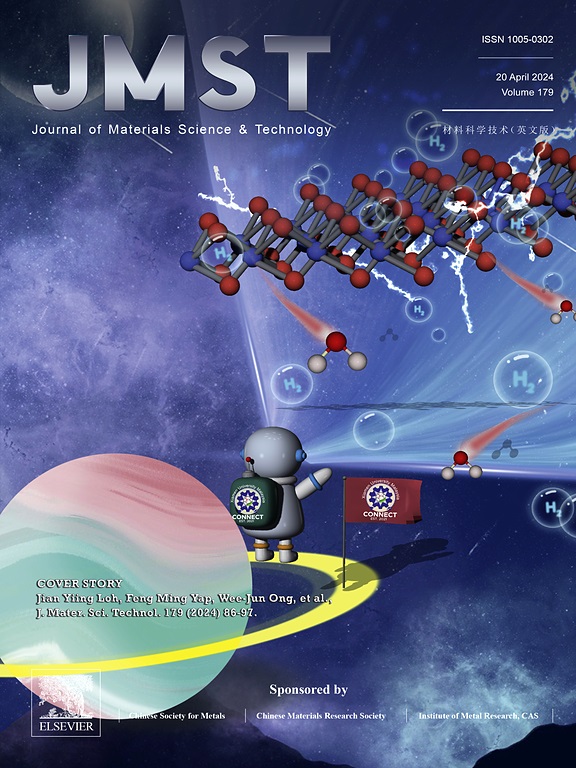Precipitation behavior and mechanical properties of 16Cr−25Ni austenitic stainless steel weld metals with different Mo content during aging
IF 11.2
1区 材料科学
Q1 MATERIALS SCIENCE, MULTIDISCIPLINARY
引用次数: 0
Abstract
In this work, 16Cr−25Ni austenitic stainless steel weld metals (WM) were prepared with Mo contents of 6.3 wt.% and 2.4 wt.%. The evolution of precipitates and their influence on the impact fracture behavior of two WMs under as-weld, post-weld heat treatment (PWHT), and aging after PWHT conditions were systematically studied. The results showed that the reduction of Mo content changed the precipitation behavior of precipitated phases in the WMs. The 6.3 wt.% Mo WM contained M6C carbides, M23C6 carbides, and M2(C, N) carbonitrides. However, only the M23C6 carbides were present in the 2.4 wt.% Mo WM. The M6C carbides remained stable in the interdendritic regions (IDRs) of the 6.3 wt.% Mo WM for aging 5000 h after PWHT. The M23C6 carbides and M2(C, N) carbonitrides aggregated in IDRs. Additionally, approximately 71 nm of M23C6 carbides precipitated semi-continuously along the grain boundaries (GBs). In the 2.4 wt.% Mo WM for aging 5000 h after PWHT, M23C6 carbides were distributed in the IDRs and dendrite core regions (DCRs). Along the GBs, continuous M23C6 precipitates about 252 nm in size were observed. As the Mo content of the WM decreased, the tensile strength decreased slightly, but its impact toughness increased significantly under different conditions. During the impact of the WMs, deformation twins, deformation bands, dislocation slip, and secondary phases interacted to influence impact toughness. Deformation twins and deformation bands contributed to the impact toughness of the WMs. However, the number of deformation twins in the 2.4 wt.% Mo WM was always higher than that in the 6.3 wt.% Mo WM. For aging 5000 h after PWHT, micron-size M6C carbides caused crack initiation, and nano-size M23C6 carbides and M2(C, N) carbonitrides clusters in the IDRs of the 6.3 wt.% Mo WM strongly impeded dislocations, making IDRs preferred paths for crack propagation. In the 2.4 wt.% Mo WM, M23C6 along GBs provided significant dislocation pinning. This caused GBs to be the primary crack initiation and propagation paths.

不同Mo含量16Cr−25Ni奥氏体不锈钢焊缝金属时效过程中的析出行为及力学性能
本文制备了Mo含量分别为6.3%和2.4 wt.%的16Cr−25Ni奥氏体不锈钢焊缝金属(WM)。系统研究了两种WMs在焊前、焊后热处理和时效条件下析出相的演变及其对冲击断裂行为的影响。结果表明,Mo含量的降低改变了WMs中析出相的析出行为。6.3 wt.% Mo WM中含有M6C碳化物、M23C6碳化物和M2(C, N)碳氮化物。然而,在2.4 wt.% Mo的WM中只存在M23C6碳化物。经PWHT时效5000 h后,M6C碳化物在6.3 wt.% Mo合金枝晶间区(IDRs)保持稳定。M23C6碳化物和M2(C, N)碳氮化物在idr中聚集。此外,沿晶界(GBs)半连续析出约71 nm的M23C6碳化物。经PWHT时效5000 h后,在2.4 wt.% Mo的WM中,M23C6碳化物分布在idr区和枝晶核区(dcr)。沿GBs方向,观察到直径约252 nm的连续M23C6析出。随着Mo含量的降低,WM的抗拉强度略有下降,但在不同条件下,其冲击韧性均显著提高。在WMs冲击过程中,变形孪晶、变形带、位错滑移和二次相相互作用影响了冲击韧性。变形孪晶和变形带对WMs的冲击韧性有影响。然而,在2.4 wt.% Mo合金中,变形孪晶的数量总是高于6.3 wt.% Mo合金。PWHT后时效5000 h,微米尺寸的M6C碳化物引起裂纹萌生,而纳米尺寸的M23C6碳化物和M2(C, N)碳氮化物团簇在6.3 wt.% Mo WM的idr中强烈阻碍位错,使idr成为裂纹扩展的首选路径。在2.4 wt.% Mo的WM中,M23C6沿GBs产生了明显的位错钉住。这使得GBs成为主要的裂纹萌生和扩展路径。
本文章由计算机程序翻译,如有差异,请以英文原文为准。
求助全文
约1分钟内获得全文
求助全文
来源期刊

Journal of Materials Science & Technology
工程技术-材料科学:综合
CiteScore
20.00
自引率
11.00%
发文量
995
审稿时长
13 days
期刊介绍:
Journal of Materials Science & Technology strives to promote global collaboration in the field of materials science and technology. It primarily publishes original research papers, invited review articles, letters, research notes, and summaries of scientific achievements. The journal covers a wide range of materials science and technology topics, including metallic materials, inorganic nonmetallic materials, and composite materials.
 求助内容:
求助内容: 应助结果提醒方式:
应助结果提醒方式:


